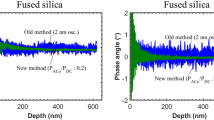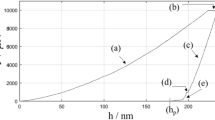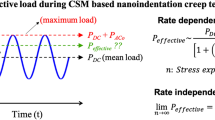Abstract
This study proposes a method developed to simultaneously solve contact hardness and reduced modulus by loading and unloading coefficients together with the inclined angle of an indenter. The ratios of the applied load to the squared slopes of load–depth curves during loading and unloading processes were used to determine loading and unloading coefficients. The values of the contact area estimated by the present method were found to be precise for a variety of materials. Compared to the reduced modulus, errors due to underestimated contact area were found more significant in the evaluation of contact hardness.
Similar content being viewed by others
References
W.C. Oliver and G.M. Pharr: An improved technique for determining hardness and elastic modulus using load and displacement sensing indentation experiments. J. Mater. Res. 7, 1564 (1992).
M. Sakai: Energy principle of the indentation induced inelastic surface deformation and hardness of brittle materials. Acta Metall. Mater. 41, 1751 (1993).
J.S. Field and M.V. Swain: A simple predictive model for spherical indentation. J. Mater. Res. 8, 297 (1993).
S. Suresh and A.E. Giannakopoulos: Determination of elastoplastic properties by sharp indentation. Scr. Mater. 40, 1191 (1999).
B. Taljat, T. Zacharia, and F. Kosel: New analytical procedure to determine stress-strain curve from spherical indentation data. Int. J. Solids Struct. 35, 4411 (1998).
B.N. Lucas, W.C. Oliver, and J.E. Swindman: The dynamics of frequency-specific, depth-sensing indentation testing, in Fundamentals of Nanoindentation and Nanotribology, edited by N.R. Moody, W.W. Gerberich, N. Burnham, and S.P. Baker (Mater. Res. Soc. Symp. Proc. 522, Warrendale, PA, 1998), pp. 3–14
T.F. Page, G.M. Pharr, J.C. Hay, W.C. Oliver, B.N. Lucas, E. Herbert, and L. Riester: Nanoindentation characterization of coated systems: P/S2—A new approach using the continuous stiffness technique, in Fundamentals of Nanoindentation and Nanotribology, edited by N.R. Moody, W.W. Gerberich, N. Burnham, and S.P. Baker (Mater. Res. Soc. Symp. Proc. 522, Warrendale, PA, 1998), pp. 53–64.
X. Li and B. Bushan: Fatigue studies of nanoscale structures for MEMS/NEMS applications using nanoindentation technologies. Surf. Coat. Technol. 163, 521 (2003).
A.C. Fischer-Cripps: Nanoindentation (Springer, New York, 2004).
P.J. Wei and J.F. Lin: A new method developed to evaluate both the hardness and elastic modulus of a coating-substrate system. Surf. Coat. Technol. 200, 2489 (2005).
M. Sakai: The Meyer hardness, a measure for plasticity?, J. Mater. Res. 14, 3630 (1999).
K.O. Kese, Z.C. Li, and B. Bergman: Method to account for true contact area in soda-lime glass during nanoindentation with the Berkovich tip. Mater. Sci. Eng., A 404, 1 (2005).
S.V. Hainsworth, H.W. Chandler, and T.F. Page: Analysis of nano-indentation load-displacement loading curves. J. Mater. Res. 11, 1987 (1996).
M. Sakai and Y. Nakano: Elastoplastic load-depth hysteresis in pyramidal indentation. J. Mater. Res. 17, 2161 (2002).
M. Sakai: Simultaneous estimate of elastic/plastic parameters in depth-sensing indentation tests. Acta Mater. 51, 391 (2004).
G. Feng and A.H.W. Ngan: Effects of creep and thermal drift on modulus measurement using depth-sensing indentation. J. Mater. Res. 17, 660 (2002).
Y.W. Zhang and S. Yang: Analysis of nanoindentation creep for polymeric materials. J. Appl. Phys. 95, 3655 (2004).
C.Y. Zhang, Y.W. Zhang, K.Y. Zeng, and L. Shen: Nanoindentation of polymers with a sharp indenter. J. Mater. Res. 20, 1597 (2005).
I.N. Sneddon: The relation between load and penetration in the axisymmetric boussinesq problem for a punch of arbitrary profile. Int. J. Eng. Sci. 3, 47 (1965).
G. Hochstetter, A. Jimenez, J.P. Cano, and E. Felder: An attempt to determine the true stress–strain curves of amorphous polymers by nano-indentation. Tribol. Int. 36, 973 (2003).
Z.Y. Li, Y.T. Cheng, H.T. Yang, and S. Chandrasekar: On two indentation hardness definitions. Surf. Coat. Technol. 154, 124 (2002).
S.E. Grillo, M. Ducarroir, M. Nadal, E. Tournie, and J-P. Faurie: Nanoindentation of Si, GaP, GaAs and ZnSe Single crystals. J. Phys. D: Appl. Phys. 36, L5 (2003).
Author information
Authors and Affiliations
Corresponding author
Rights and permissions
About this article
Cite this article
Wei, P.J., Lin, J.F. Modified method for continuous stiffness measurement. Journal of Materials Research 24, 599–606 (2009). https://doi.org/10.1557/jmr.2009.0087
Received:
Accepted:
Published:
Issue Date:
DOI: https://doi.org/10.1557/jmr.2009.0087




